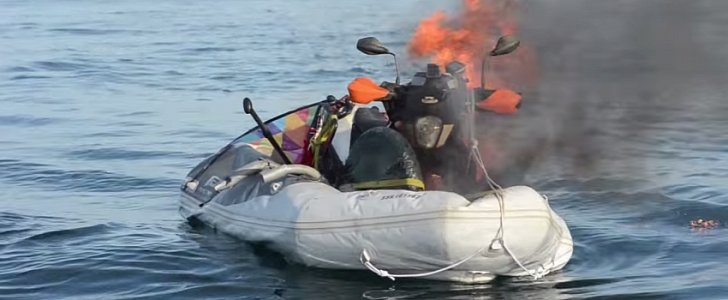Francis, Patrick and Tim are three adventure riders who want to extend the capabilities of a motorcycle to the point where it can cross large distances covered with water. If rivers are the first thing that comes to your mind, how about we tell you that these fellows want to use their boatorcycles to cross the Bering Strait?
The term boatorcycle is most likely a familiar one for the three adventurers, but it may sound a bit off to people with no knowledge about the BikeBoat project. The BikeBoat was born from the need to have a bike crossing larger water surfaces, with the ultimate goal being to use them for crossing the Bering Strait on a trip from Russia to Alaska.
After successfully passing hundreds of kilometers of tests, Francis Lamotte wanted to see how his BikeBoat would fare in a crossing of the English Channel. Despite all the things working as planned in the beginning, it looks like the biggest problem of a boatorcycle is overheating.
Basically, a BikeBoat is an inflatable boat in which the bike sits, while the chain drives a propeller. The BikeBoat can do around 10 knots, and this means 18.5 km/h or 11.5 mph. While this speed could be enough for a bike crossing a portion of a sea, it proved nowhere near enough to keep the bike cool.
The whole thing overheated and caused a fatal failure in one fo the fuel tanks which ruptured and burst into flames. Francis was able to swim to safety, but the whole thig caught on fire and sunk at the bottom of the English Channel.
Cutting some video gear loose from the sinking wreck was the least they could do. A successful attempt, as far as floating ability and speed are concerned, this test leaves the team with some extra things to do.
They are now raising money to recover their bike and implement better cooling solutions. Here's how the battle plan changes for them:
Francis, Patrick and Tim are waiting for your support and you can lend them a helping hand funding their research on Indiegogo. You can help by getting stickers, prints or even buy yourself a day for tinkering around in their workshop in Grenoble, France.
Overheating is now the biggest problem
Hundreds of hours have been spent designing and testing a belt transmission system that conveys power from the chain drive to the propeller. Also, the whole boat part had to be optimized to fit on the bike as part of the cargo.After successfully passing hundreds of kilometers of tests, Francis Lamotte wanted to see how his BikeBoat would fare in a crossing of the English Channel. Despite all the things working as planned in the beginning, it looks like the biggest problem of a boatorcycle is overheating.
Basically, a BikeBoat is an inflatable boat in which the bike sits, while the chain drives a propeller. The BikeBoat can do around 10 knots, and this means 18.5 km/h or 11.5 mph. While this speed could be enough for a bike crossing a portion of a sea, it proved nowhere near enough to keep the bike cool.
The whole thing overheated and caused a fatal failure in one fo the fuel tanks which ruptured and burst into flames. Francis was able to swim to safety, but the whole thig caught on fire and sunk at the bottom of the English Channel.
Cutting some video gear loose from the sinking wreck was the least they could do. A successful attempt, as far as floating ability and speed are concerned, this test leaves the team with some extra things to do.
They are now raising money to recover their bike and implement better cooling solutions. Here's how the battle plan changes for them:
- Hire divers and a boat with side-scan sonar to attempt to salvage Francis' motorbike - and more importantly, the all-important propulsion system - off the bottom of the English Channel. This is not at all guaranteed as it's extremely hard to locate objects in one of the busiest shipping lanes in the world, but we believe it's worth trying;
- Construction of three amphibious boatorcycle systems (boats and the propulsion belt system) for Francis, Patrick and Tim ready to cross the Bering Straight in the summer of 2016;
- Modification of our existing motorbikes to improve cooling and reliability, to reduce the chance of overheating;
- Release of open-source plans and design notes for the whole system, to permit others to follow in our footsteps!
Francis, Patrick and Tim are waiting for your support and you can lend them a helping hand funding their research on Indiegogo. You can help by getting stickers, prints or even buy yourself a day for tinkering around in their workshop in Grenoble, France.

